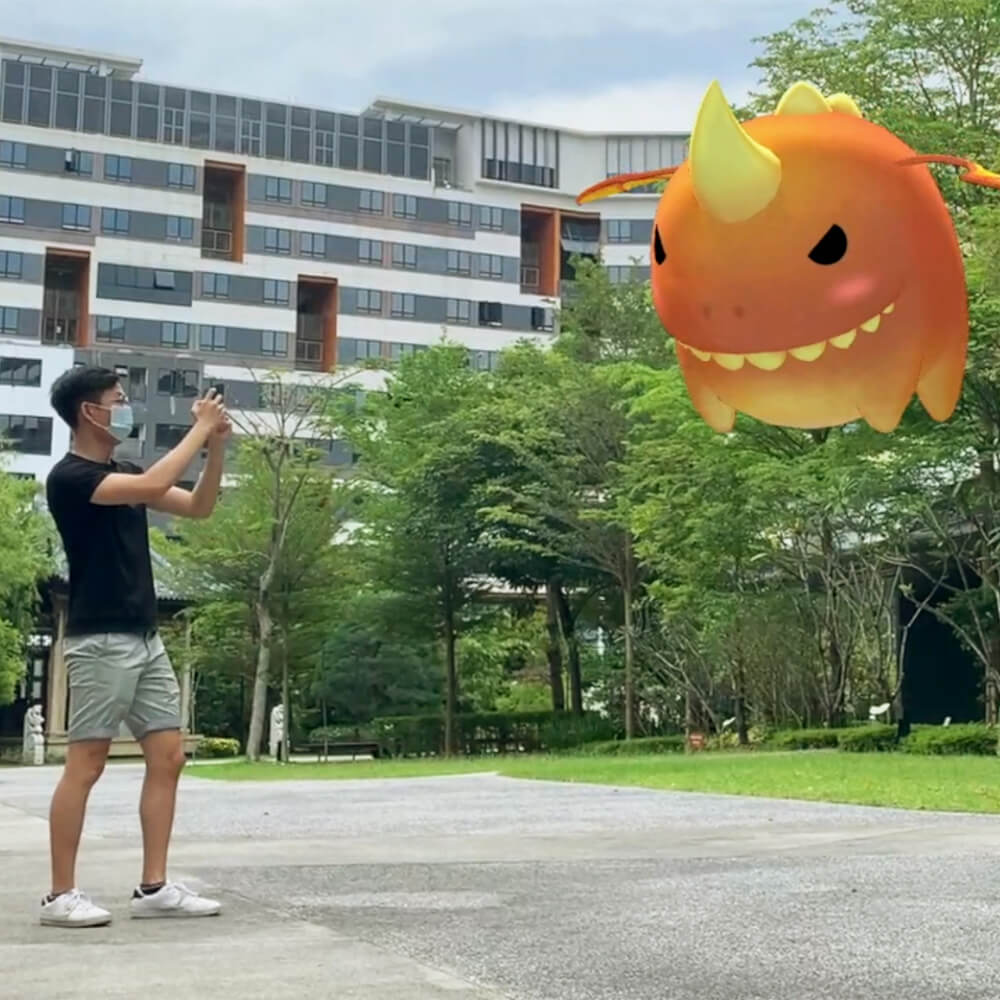Singapore University of Technology and Design’s (SUTD) offers a truly interdisciplinary education that produces students who aren’t afraid to push the boundaries of design and interdisciplinary innovation. It’s where students address real-world challenges by creating innovative solutions, unconstrained by traditional confines. Just take CrowdFlux, for instance. The project pioneered by Raphael Yee and four other classmates takes inspiration from the popular game, Pokémon GO, to stem overcrowding in a shopping mall.
“When overcrowding is detected, we use an algorithm to spawn rare augmented reality creatures around the mall, incentivising mall patrons to move to the zones to ‘catch’ the creatures — thus causing crowd dispersion,” explains the Information Systems Technology and Design (ISTD) student.
CrowdFlux is a gamification system that was designed through the understanding of human-centric design, powered by technology. Their solution aimed to be non-disruptive, interactive and fun as current measures in place may feel invasive, induce anxiety and skewed towards negative reinforcements for some.
CrowdFlux was designed with technologies that respond based on environmental cues to reduce overcrowding that could pose health and safety threats. It detects, collects and calculates crowding data at a mall, before incentivising patrons to move from crowded areas to less crowded spaces through AR gamification rewards.

CrowdFlux, created by Raphael Yee and four classmates, takes inspiration from Pokémon GO to disperse crowds. Source: CrowdFlux
Such systems-based approach in thinking is why SUTD has been acknowledged as “the foremost leader in engineering education” by the Massachusetts Institute of Technology (MIT).
Raphael and his teammates were fulfilling an assignment for the Design Thinking and Innovation course within their Freshmore year. A trademark of SUTD’s unique pedagogy, this course introduces students to concepts of design at a variety of scales and design disciplines. Raphael and his team were taught by a team of instructors comprising architects and engineers. Eschewing a traditional faculty structure, SUTD’s interdisciplinary curriculum merges the technical aspects of innovation with future-forward, human-centred designs for a better world.
Having graduated with a diploma in Film from an Arts school, Raphael attests that students from non-science backgrounds are also capable of excelling in the course and driving innovation, thanks to SUTD’s supportive learning environment. “Coming from different backgrounds in software, hardware, and design, we contributed in our own ways to make the project a success,” he says.
Tapping into a wellspring of ingenuity


Such systems-based approach in thinking is why SUTD has been acknowledged as “the foremost leader in engineering education” by the Massachusetts Institute of Technology (MIT).
The pandemic gave rise to the importance of public space designs, fuelling the need for architectural solutions that consider both a site’s historical background and prevailing restrictions on gathering at public spaces. Similarly, quarantine and physical distancing inspired Chi Jia Cai to create speculative interventions to reconfigure spaces post-pandemic and beyond via his To-Gather Apart project.
The Master of Architecture and 2020 ASD Pillar Awards winner was pushed to look beyond functionality when he formulated plans for new floor murals and furniture systems at South Beach’s public courtyard. Jia Cai created a semi-concentric floor mural design with a two meter-by-two meter grid system. This helps people maintain a safe distance, in line with the latest guidelines on gathering sizes.
His work embodies the innovative and revolutionary design approaches of SUTD’s Architecture and Sustainable Design (ASD) programme. Under the tutelage of his studio instructor, Dr Chong Keng Hua, one of Singapore’ leading figures in social architecture, Jia Cai further fine-tuned his proposal to its award-winning form.
True to SUTD’s concerted faculty approach, the faculty engage and work closely with their students throughout their educational journey. “In SUTD, the instructors are always encouraging in challenging the norm and critically addressing the root of issues to come up with innovative and concise solutions,” notes Jia Cai. Without his professor’s guidance in ensuring the relevancy and usability of the design solution, Jia Cai believes it would not have been possible for him to craft a solution that resonates well with the public.
“The combined scheme of new floor murals and furniture system allows for easy adaptation of spatial configuration at the public courtyard across the different stages of regulation while still ensuring safe distancing among the users of the space,” says the 25-year-old. “This allows the F&B businesses along the courtyard to use the naturally ventilated open-air space for alfresco dining purposes with minimal business disruptions.”
He credits SUTD for empowering students with advanced design methodologies and real-world experience. “SUTD’s ASD pillar has become a trailblazer in what a contemporary architecture education looks like”, he says.
People-centric solutions for a changing world
Prolonged lockdowns birthed feelings of disconnection, and many took to new hobbies to fill the void. For Jerry Neo, an Engineering Product Development (EPD) student who specialised in Computer Engineering and minored in Computer Science, his Eureka moment struck while working through some home improvement projects. That was how Scratchbac, a proximity-based social utility app that unlocks the power of communities and connects people in need of assistance, was created during the 2020 circuit breaker. This Telegram bot connects people within a 1km radius to share resources and help with errands, such as delivering food to elderly neighbours. Today, Scratchbac has over 60,000 users across Singapore.

Scratchbac is a proximity-based social utility app to connect people in need of assistance. Source: Scratchbac
“I was installing a shelf rack and needed a drill. That was the ‘ah-ha’ moment. There are hundreds of families in my block alone, surely one of them has a drill to lend,” he recalls. After recruiting teammates Cheryl Low and Princeton Poh to contribute in design and technology development, the team grew and is set to launch their Kickstarter campaign soon. The interdisciplinary nature of SUTD’s framework means that digital literacy is prioritised in design and innovation to produce in-demand graduates. This approach has also benefited the university’s faculty.
“Coming from a large US university, I know how siloed a university can be and how difficult it is to meet and work with faculty in different disciplines,” says Professor Peter Jackson, Head of Pillar for Engineering Systems and Design (ESD) and Director of Aviation Studies Institute (ASI). His interactions with professors from other departments inspired new applicable techniques to his own work.
Together with the Weill Cornell Medical College in New York, he built predictive mathematical models based on analytics to model a user-friendly tool estimating hospital demands for critical resources, assisted by students who ran checks on the prototype.


Possible Epidemic Curves and System Dynamics. Source: SUTD
Emphasising the need for data-driven knowledge, he adds, “Whether you are talking about genetics or material science, unmanned vehicles or hospital waiting rooms, the power of data analytics and the tools of artificial intelligence are providing unified ways to approach and solve a host of problems.”

Source: Shutterstock
As rapid testing becomes more ubiquitous, EPD Associate Professor Huang Shaoying looks to take things to the next level. She is a member of a project at SUTD experimenting with a microwave-based screening for COVID-19 using saliva that can detect the virus in under five minutes.
“The project is interdisciplinary, and the process is woven with design thinking,” explains the professor. It’s precisely the sort of unconventional inquiry that keeps SUTD ahead of the field while putting societal concerns at the forefront of innovation.
Discover future-forward programmes
What sets SUTD apart from other universities worldwide is its non-traditional architecture and engineering degree programmes. These are unconstrained by prescribed ideas of what design should entail. SUTD’s openness to test and break new frontiers of innovation make for a novel learning experience.
Ultimately, through human-centric Design and Technology, their students create solutions for present and future challenges. As Professor Jackson succinctly puts it, “Innovation is a state of mind: a willingness to be playful. Do you fear having fun?”
Unearth your originality to become a leader in design technology here.
Join SUTD to be part of a new generation of Design Innovators! Click here for more info










